Fchamel
Chameleon Enthusiast
Okay ?Further to this, none of these programs are stand-alone aspects of husbandry. They are each a working part of a whole husbandry effort that includes proper temps/hydration/uvb, etc.
Follow along with the video below to see how to install our site as a web app on your home screen.
Note: This feature may not be available in some browsers.
Okay ?Further to this, none of these programs are stand-alone aspects of husbandry. They are each a working part of a whole husbandry effort that includes proper temps/hydration/uvb, etc.
Cost should not matter because the stuff will probably last the life of your reptile.
And LLL is super slow, I have ordered twice and it can take over a MONTH
Stuff happens when your entire state is on fire
2 orders a year apart. Never get any confirmation if it is on its way or not. OH and last time they sent me the wrong thing, but because I never got confirmation I cant do any thing.
Sorry their mail order is terrible.
In fairness I have been in their Vegas store (10 yrs ago) and a large number of animals all well cared for.
If somebody could just use one supplement, why would someone choose the traditional method?1) The repashy all-in-one program:
- just dust with “ repashy calcium plus LoD” at every feeding: used mainly with veileds and panthers, who appear to be less sensitive to supplementation than montanes
Okay, thank you! ?vitamins expire after 2 years. Calcium is around 5 years.
That is true. But I already have the traditional ones, so that's why I'm going with it.If somebody could just use one supplement, why would someone choose the traditional method?
There are several reasons, so far as I can tell. 1) Because certain montane species develop edema with supplementation with things such as repashy calcium plus LoD. With the traditional approach, a keeper can choose to supplement with vitamins less frequently...say, once, rather than twice per month. 2) Some keepers chose not to use any fat soluble vitamins, and so many of the all in ones won’t work. 3) Because the traditional method has the longest history of success in the hobby, since it has been around for the longest. 4) some keepers want more control over what, besides pure calcium, goes to their pets. Again, I take no stance on the merits of any one supplementation regime. I like my regime because it works for me and all the species I keep; but it works for me because of some of the other aspects of my husbandry, and might not work in every situation.If somebody could just use one supplement, why would someone choose the traditional method?
4 sounds the easiest. Do you just measure it out by volumetric or do weigh it in grams? What happens with the Arcadia calcium with D3?There is not a single correct supplement regime, but several that can be used successfully.
1) The repashy all-in-one program:
- just dust with “ repashy calcium plus LoD” at every feeding: used mainly with veileds and panthers, who appear to be less sensitive to supplementation than montanes
2) The traditional program:
- dust with plain calcium (no d3) at every feeding; twice a month, dust with multivitamin; twice a month dust with calcium with d3 (or else use a multivitamin that contains d3)
3) The Arcadia program
- dust with earth pro A every feeding
- every 8 th or 16th feeding, dust with calcium pro mg
- every 8th or 16th feeding, dust with their new product that has all the fat solubles
4) What I do:
- Mix earthpro A and calcium pro mg together in the ratio of 14 parts earthpro a to 1 part calcium pro mg.
- use this at every feeding, and work really hard on bug nutrition and good uvb.
By volume, but please keep in mind that this regime contains no d3, and no preformed A. That is a deliberate choice that I think I’m on top of with my uvb situation and insect feeding regime. However, I am a revisionist about chameleon husbandry: if I see good reasons for changing how I keep my chams—eg eye issues, skin problems, early signs of mbd—then I will revise my husbandry. I also go to pretty monumental lengths to feed my bugs.4 sound the easiest. Do you just measure it out by volumetric or do weigh in grams?
What do you feed your bugs besides the sweet potatoes, carrots, veggies and fruit?By volume, but please keep in mind that this regime contains no d3, and no preformed A. That is a deliberate choice that I think I’m on top of with my uvb situation and insect feeding regime. However, I am a revisionist about chameleon husbandry: if I see good reasons for changing how I keep my chams—eg eye issues, skin problems, early signs of mbd—then I will revise my husbandry. I also go to pretty monumental lengths to feed my bugs.
Yikes, that’s a very long answer. Here’s a batch I made last Year:What do you feed your bugs besides the sweet potatoes, carrots, veggies and fruit?
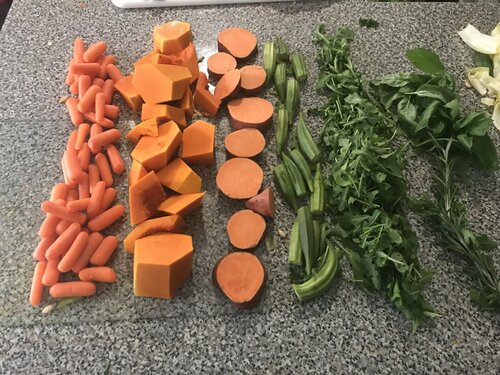
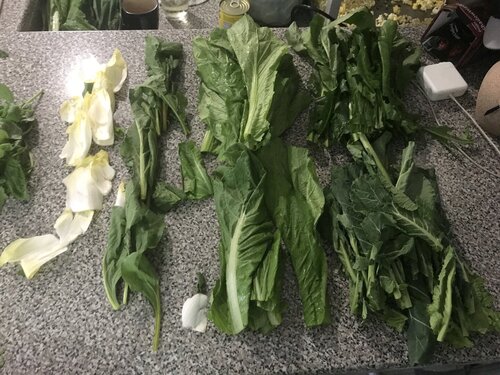
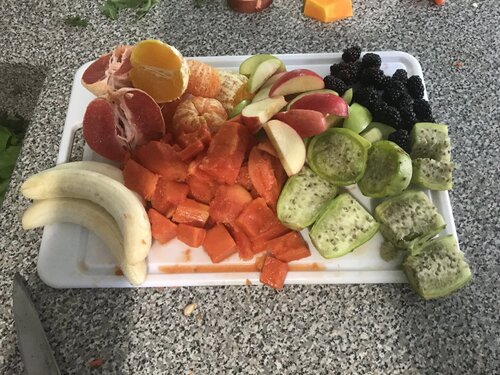
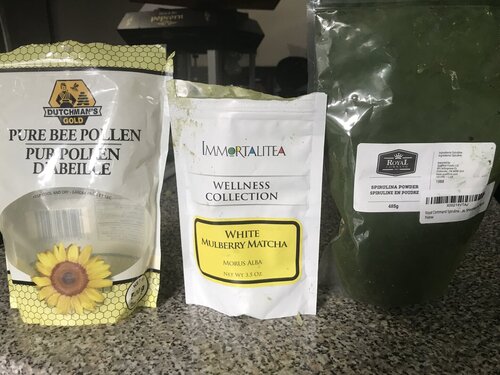
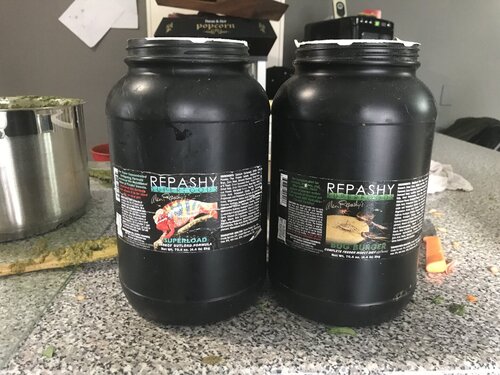
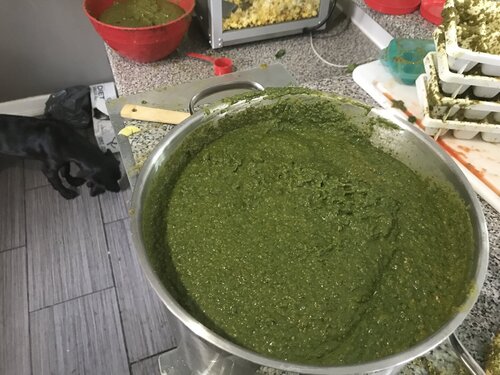
I don’t use Arcadia’s new supplement with d3.4 sounds the easiest. Do you just measure it out by volumetric or do weigh it in grams? What happens with the Arcadia calcium with D3?
I suspect each feeder will process this differently, and end up benefiting/Paying forward nutrition to your chameleons differently.Since then, I’ve added some additional powdered elements. Basically, I roughly proportion out my ingredients so that the high calcium greens (collards, dandelion, etc.) occupy at least 50-70% of the gutload, and then use the other ingredients as 30-50%. The usual spread is about 60/40 for high calcium greens. I then blend the whole mess of stuff into a green muck that I freeze into dozens of ice cube trays the cubes are then vacu-sealed into freezer bags and frozen. I use some elements such as banana in very small quantities, not because they are especially beneficial, but because even 1/4 of a banana will make the bugs go nuts over the smell. Then, I just add a cube or two everyday to the bins. No need for water in the bins, as the cubes supply sufficient moisture.